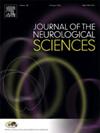新诊断复发缓解型多发性硬化症患者灰质微观结构的时空变化:纵向扩散峰度MRI研究
IF 3.6
3区 医学
Q1 CLINICAL NEUROLOGY
引用次数: 0
摘要
在多发性硬化症(MS)中,神经变性发生在白质(WM)和灰质(GM)。使用磁共振成像(MRI)估计GM微结构改变与临床残疾和脱髓鞘性WM病变相关。因此,MRI测量GM微结构可能是MS的早期生物标志物。目的本研究旨在探讨新诊断的复发-缓解型MS (RRMS)患者皮质和皮质下GM微结构特征与临床残疾之间的关系。其次,该研究探讨了与临床残疾和WM病变体积变化相关的组织微观结构的潜在纵向改变。方法对72例新诊断的RRMS患者进行生理和认知测试,并在基线和48周后进行MRI结构和弥散峰度扫描。结果基线时,WM病变体积与皮层、丘脑(r2 = 0.52)、尾状核(r2 = 0.40)、壳核(r2 = 0.37)的平均弥散度(MD)及丘脑体积(r2 = 0.67)相关。纵向上,从基线到48周,病变体积的增加与皮质md的时空增加有关。结论皮质和皮质下GM的微观结构与RRMS患者病变体积的程度和变化有关。弥散MRI可作为MS中WM损伤和纵向神经变性的替代指标。本文章由计算机程序翻译,如有差异,请以英文原文为准。
Spatiotemporal alterations of gray matter microstructure in newly diagnosed relapsing-remitting multiple sclerosis patients: A longitudinal diffusion kurtosis MRI study
Background
In multiple sclerosis (MS), neurodegeneration occurs in both white matter (WM) and gray matter (GM). Altered GM microstructure, estimated using magnetic resonance imaging (MRI), correlates with clinical disability and demyelinating WM lesions. Therefore, MRI measurements of GM microstructure may be an early biomarker in MS.
Objectives
The study aims to investigate the association between the microstructural characteristics of cortical and subcortical GM and clinical disability in newly diagnosed patients with relapsing-remitting MS (RRMS). Secondarily, the study investigates potential longitudinal alterations of tissue microstructure in relation to clinical disability and changes in WM lesion volume.
Methods
Eighty-two newly diagnosed RRMS patients were physically and cognitively tested and brain scanned using structural and diffusion kurtosis MRI at baseline and after 48 weeks.
Results
At baseline, WM lesion volume correlated with mean diffusivity (MD) in cortex, thalamus (r2 = 0.52), caudate (r2 = 0.40) and putamen (r2 = 0.37), and with thalamus volume (r2 = 0.67). Longitudinally, increased lesion volume from baseline to 48 weeks was associated with a spatiotemporal increase in cortical MD.
Conclusions
The microstructure of cortical and subcortical GM is associated with both the degree and change of lesion volume in patients with RRMS. Diffusion MRI could serve as a surrogate measure of WM injury and longitudinal neurodegeneration in MS.
求助全文
通过发布文献求助,成功后即可免费获取论文全文。
去求助
来源期刊

Journal of the Neurological Sciences
医学-临床神经学
CiteScore
7.60
自引率
2.30%
发文量
313
审稿时长
22 days
期刊介绍:
The Journal of the Neurological Sciences provides a medium for the prompt publication of original articles in neurology and neuroscience from around the world. JNS places special emphasis on articles that: 1) provide guidance to clinicians around the world (Best Practices, Global Neurology); 2) report cutting-edge science related to neurology (Basic and Translational Sciences); 3) educate readers about relevant and practical clinical outcomes in neurology (Outcomes Research); and 4) summarize or editorialize the current state of the literature (Reviews, Commentaries, and Editorials).
JNS accepts most types of manuscripts for consideration including original research papers, short communications, reviews, book reviews, letters to the Editor, opinions and editorials. Topics considered will be from neurology-related fields that are of interest to practicing physicians around the world. Examples include neuromuscular diseases, demyelination, atrophies, dementia, neoplasms, infections, epilepsies, disturbances of consciousness, stroke and cerebral circulation, growth and development, plasticity and intermediary metabolism.
 求助内容:
求助内容: 应助结果提醒方式:
应助结果提醒方式:


